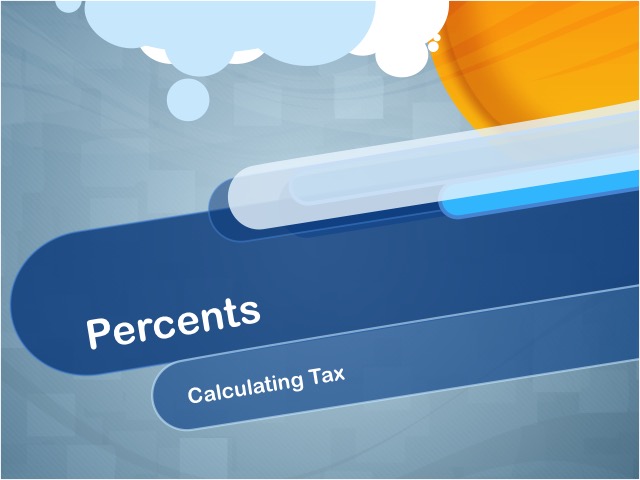
Display Title
Closed Captioned Video: Percents: Calculating Tax
Display Title
Closed Captioned Video: Percents: Calculating Tax
Topic
Percents
Description
This video covers tax calculations for purchases, property, and VAT. Examples include grocery bills, iPad purchases, and real estate property taxes. Applications highlight the importance of understanding tax rates for budgeting and financial management.
The video demonstrates mathematical principles and connects them to real-world scenarios. It aligns with the topic by breaking down key concepts and presenting them with clarity. This understanding is crucial for developing mathematical proficiency in the area of percents. Percents are not only a fundamental mathematical concept but also widely used in everyday life, such as in calculating discounts, interest rates, and proportions.
Teacher's Script: "In this video, we’ll explore how to approach calculations involving percents, such as finding the percent of a number or determining percent changes. As you watch, think about how the visual representations and calculations connect to what we’ve been learning about percents. This will help you see the practical use of these skills in solving problems effectively."
For a complete collection of videos related to Percents click on this link: Video Tutorials: Percents Collection.
What Are Percents?
Percents are a type of fraction. A fraction is part of a whole.
When you think of fractions, you usually think of a numerical expression that looks like this:
A percent is a special type of fraction, as you can see here. When written as a fraction, a percent has a denominator of 100.
If you see a fraction with 100 in the denominator, think of it as a percent. In fact, the word “percent” literally means “out of 100.” An alternative to writing a percent as a fraction is to use the percent symbol, or %.
Converting Fractions to Percents
When comparing fractions, sometimes it's easier to convert them to percents. Take a look at these examples.
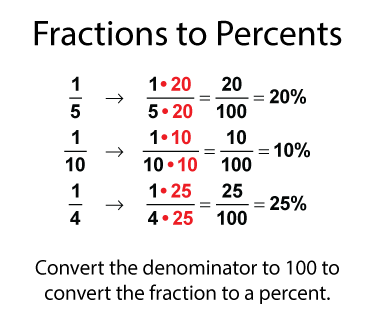
In each case, the denominator of the fraction isn't 100. Multiply the numerator and denominator by the same number to convert the denominator to 100. When you do that, you can write the fraction as a percent. The reason for multiplying the numerator and denominator by the same number is to not change the value of the fraction.
What if you have a fraction that isn't a factor of 100? In those case, you can divide the numerator by the denominator and multiply the result by 100%. Here's an example.

Why Convert Fractions to Percents?
When comparing fractions, sometimes it's easier to make these comparisons when the fractions are rewritten as percents. Take a look at this table, which lists fractions and their corresponding percent values.
| Fraction | Percent |
| 1/8 | 12.5% |
| 1/4 | 25% |
| 1/2 | 50% |
| 3/5 | 60% |
Do you see how much easier it is to compare and order fractions, if you are comparing the corresponding percent values?
Visual Models for Percents
You can use a visual model to represent percents. A 10 x 10 grid is made up of 100 smaller squares. Each small square represents 1%.
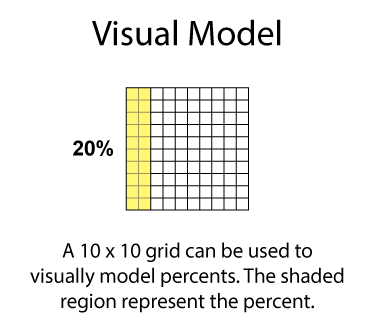
Visual models are useful when first learning about percents.
Percents as Decimals
You saw previously how fractions can be converted to decimals and then percents. Percents can also be represented as decimals.
Here's a way to convert a percent to a decimal using place value. Starting at the decimal point, shift it two places to the left and write the percent symbol. Here are several examples.

Use this technique when you need to find the percent of a number,
Percent of a Number
Since a percent is a type of fraction, then finding the percent of a number is the same as finding the fractional amount of a number. The simplest way to find the percent of a number is to multiply by the corresponding decimal value. Here are two examples.
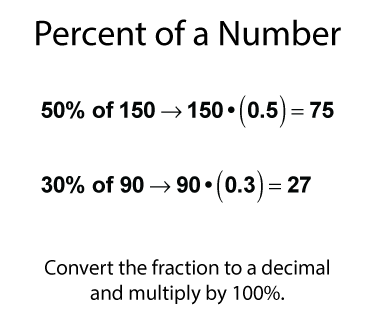
There are many examples of finding the percent of a number. One of the most common is the tax on a purchase. Suppose there's a 5% sales tax and you purchase a $25 item. What's the amount of tax owed? The calculation is shown below.
25 • 5% = 25 • (0.05) = 1.25
Percent Increase
When one number changes in value, that represents a percent change. For example, if you have money in a savings account and it earns interest, this is an example of percent increase. Here is the formula for calculating percent increase.
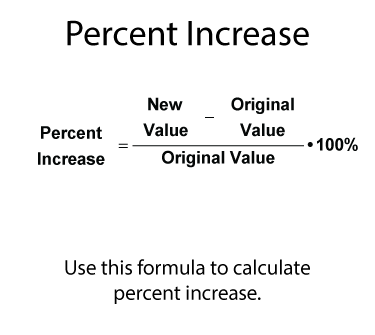
Suppose you bought a souvenir for $50 and resold it for $75. What is the percent increase in the value of the souvenir? Follow the steps for calculating the percent increase.
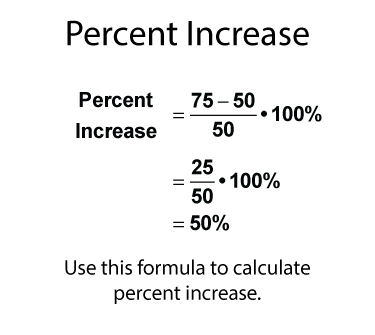
Percent Decrease
Suppose a number decreases in value. That also represents a percent change. In this case it is a percent decrease. Use the same formula to calculate the percent decrease.
Solving Percent Equations
Percents play an important role in solving equations. There are three types of equations that involve percents:
- Finding the percent of a number: x = a% • b.
- Finding the percent one number is of another: a • x% = b.
- Finding the whole given the percent: x • a% = b.
Study these three equation types and you'll be able to solve most problems that involve percents. As you solve word problems involving percents, you will likely be working with one of these equation types.
| Common Core Standards | CCSS.MATH.CONTENT.6.RP.A.3, CCSS.MATH.CONTENT.7.RP.A.2, CCSS.MATH.CONTENT.6.RP.A.3.C |
|---|---|
| Duration | 3.5 minutes |
| Grade Range | 6 - 8 |
| Curriculum Nodes |
Algebra • Ratios, Proportions, and Percents • Percents |
| Copyright Year | 2020 |
| Keywords | percents, percents video tutorials, tax rates, video tutorial, taxes, Closed Captioned Video |